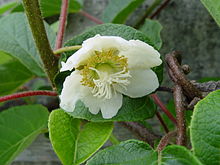Actinidiaceae
| Actinidiaceae | |
|---|---|

| |
| Actinidia deliciosa | |
| Scientific classification | |
| Kingdom: | Plantae |
| Clade: | Tracheophytes |
| Clade: | Angiosperms |
| Clade: | Eudicots |
| Clade: | Asterids |
| Order: | Ericales |
| Family: | Actinidiaceae Gilg & Werderm.[1] |
| Type genus | |
| Actinidia | |
| Genera | |
The Actinidiaceae are a small family of flowering plants. The family has three genera and about 360 species and is a member of the order Ericales.[2]
Distribution
[edit]They are temperate and subtropical woody vines, shrubs, and trees, native to Asia (Actinidia or kiwifruit, Clematoclethra, and Saurauia) and Central America and South America (Saurauia only). Saurauia, with its 300 species, is the largest genus in this family. Although now confined to Asia and tropical Central and South America, evidence indicates in the past the family had a wider distribution. The now extinct genus Parasaurauia is thought to have belonged to the Actinidiaceae and lived in North America during the early Campanian.[3]
Characteristics
[edit]The plants are usually small trees or shrubs, or sometimes vines (Actinidia). The alternate, simple, spiral leaves have serrated or entire margins. They lack stipules or are minutely stipulated. They are often beset with rather flattened bristles.
The flowers grow solitary or are aggregated in terminal cymes, with free sepals and petals. Except for members of the genus Clematoclethra which have 10 stamens, the stamens are numerous and originally attached at the back.[3] They invert just before the flower starts expanding, so their bases become apical.
The plants may be dioecious, monoecious, or hermaphroditic. The fruit is usually a berry, such as the edible kiwifruit, a cultivar from the genus Actinidia.
Evidence supporting placement within the Ericales
[edit]Before genetic evidence appeared in the last 10 years, the placement of the Actinidiaceae within the Ericales was highly controversial. The USDA Plants Database, a resource considered authoritative, still places the Actinidaceae within the Theales, an order which has been shown not to be monophyletic.[4] Placement of the Actinidiaceae within the Ericales has been strongly supported recently by genetic evidence, and contrary to previous thought, it is not a basal member of the Ericales. Multiple studies using genetic evidence now firmly place the Actinidiaceae in the Ericoid clade, a monophyletic group consisting of the Ericaceae, the Cyrillaceae, the Clethraceae, the Sarraceniaceae, and the Roridulaceae. Further genetic evidence points to the Actinidiaceae being sister to the Roridulaceae, with the Roridulaceae and Sarraceniaceae, forming another, smaller, monophyletic group.[5]
Evidence supporting monophyly of the Actinidiaceae
[edit]What genera were to be placed in the Actinidiaceae before recent genetic and micromorphological studies emerged was highly controversial. Before recent evidence, the genus Sladenia was often placed within the Actinidiaceae. Also, Saurauia was sometimes considered its own family. Thus, before more detailed studies started, two to four genera could be placed within the Actinidiaceae. Micromorphological characters have confirmed that Sladenia does not belong in the Actinidiaceae. Furthermore, biological characteristics of the cells, and molecular evidence have confirmed the three genera currently circumscribed in the Actinidiaceae, Clematoclethra, Saurauia, and Actinidia, do indeed form a monophyletic group.[6][7]
References
[edit]- ^ Angiosperm Phylogeny Group (2009). "An update of the Angiosperm Phylogeny Group classification for the orders and families of flowering plants: APG III" (PDF). Botanical Journal of the Linnean Society. 161 (2): 105–121. doi:10.1111/j.1095-8339.2009.00996.x. hdl:10654/18083. Retrieved 2013-07-06.
- ^ Anderberg, Arne A.; Rydin, Catarina; Källersjö, Mari (2002). "Phylogenetic relationships in the order Ericales s.l.: analyses of molecular data from five genes from the plastid and mitochondrial genomes". American Journal of Botany. 89 (4): 677–687. doi:10.3732/ajb.89.4.677. PMID 21665668.
- ^ a b Keller, Jennifer A.; Herendeen, Patrick S.; Crane, Peter R. (1996). "Fossil flowers and fruits of the Actinidiaceae from the Campanian (Late Cretaceous) of Georgia". American Journal of Botany. 83 (4): 528–541. doi:10.1002/j.1537-2197.1996.tb12733.x.
- ^ The Angiosperm Phylogeny Group (531–553). "An Ordinal Classification for the Families of Flowering Plants". Annals of the Missouri Botanical Garden. 85 (4): 531–553. doi:10.2307/2992015. JSTOR 2992015.
- ^ Schönenberger, Jürg; Anderberg, Arne A.; Sytsma, Kenneth J. (March 2005). "Molecular Phylogenetics and Patterns of Floral Evolution in the Ericales". International Journal of Plant Sciences. 166 (2): 265–288. doi:10.1086/427198. S2CID 35461118.
- ^ Li, Jianqiang; Huang, Hongwen; Sang, Tao (2002). "Molecular Phylogeny and Infrageneric Classification of Actinidia (Actinidiaceae)". Systematic Botany. 27 (2): 408–415. doi:10.1043/0363-6445-27.2.408 (inactive 2024-09-12). JSTOR 3093880.
{{cite journal}}: CS1 maint: DOI inactive as of September 2024 (link) - ^ He, Zi-Can; Li, Jian-Qiang; Cai, Qing; Wang, Qing (2005). "The cytology of Actinidia, Saurauia, and Clematoclethra(Actinidiaceae)". Botanical Journal of the Linnean Society. 147 (3): 369–374. doi:10.1111/j.1095-8339.2005.00372.x.
